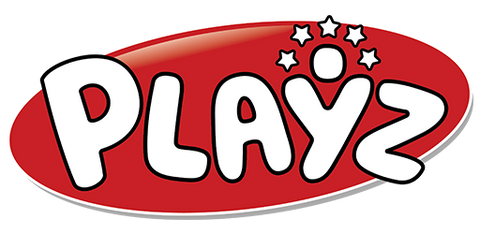
8 Awesome Engineering Activities for Kids to Try in 2025
In a world driven by innovation, nurturing the next generation of builders, thinkers, and problem-solvers has never been more crucial. How do you introduce complex concepts like structural integrity or electrical circuits in a way that’s engaging, not intimidating? The answer is simpler than you think: through hands-on play. Engineering is not just about blueprints and complex math; it's about curiosity, creativity, and the simple joy of making something work.
This guide is your launchpad into the world of hands-on learning, featuring eight engineering activities for kids that transform everyday materials into powerful educational tools. Forget boring lectures; we're building bridges with household items, launching catapults with rubber bands, and exploring simple hydraulics with syringes. We’ll show you how to turn your home into a vibrant lab where failure is just another step toward success.
Each activity is designed to be fun, accessible, and packed with learning outcomes that build critical skills for the future. From understanding structural stability to grasping the basics of coding and robotics, these projects provide a solid foundation in STEM principles. We’ll provide the required materials, step-by-step instructions, and key learning takeaways to make your next project a memorable one.
1. Building Bridges with Household Materials
One of the most classic and effective engineering activities for kids is designing and building bridges from common household materials. This hands-on project introduces young minds to the core principles of civil and structural engineering, challenging them to create a structure that can span a gap and support a load. By using simple items like popsicle sticks, straws, tape, and glue, children can explore complex concepts in a tangible and exciting way.
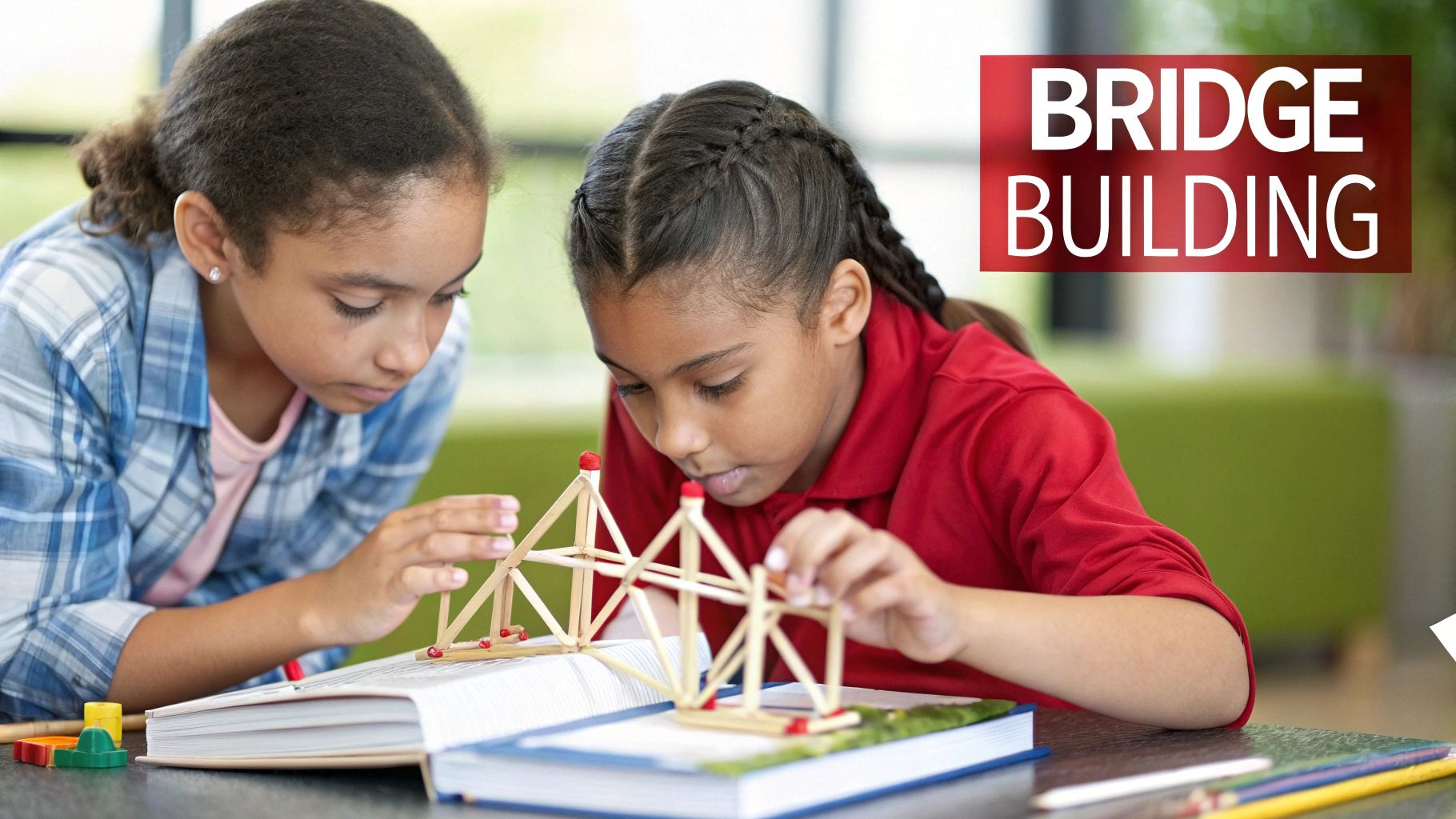
The goal is to bridge a set distance, such as the space between two books or chairs, and then test the bridge's strength by incrementally adding weight. This simple test reveals the fundamentals of tension (pulling forces) and compression (pushing forces) and how different shapes and materials distribute load. This activity is a cornerstone in many STEM programs, from local science fairs to national competitions like the Science Olympiad, proving its educational value across age groups.
Core Engineering Concepts
This activity brings several foundational engineering ideas to life:
- Structural Integrity: Kids learn how shapes like triangles (in truss bridges) provide superior strength and stability.
- Load Distribution: They see firsthand how their design spreads the weight of the "traffic" across the structure.
- Design Process: The project mirrors the real-world engineering cycle of brainstorming, designing, building, testing, and iterating.
Actionable Insights: How to Get Started
To make this engineering activity a success, provide clear goals and encourage creative problem-solving.
- Set the Challenge: Define the span your child's bridge must cross (e.g., 12 inches) and the materials they can use.
- Sketch First: Encourage kids to draw their designs on paper before they start building. This planning phase is crucial for engineers.
- Test and Improve: Use pennies, small toys, or washers to test the load capacity. Discuss why a bridge failed and how it could be reinforced. Was it a material failure or a design flaw?
- Introduce Constraints: For an added challenge, create a "budget" for materials (e.g., 50 popsicle sticks, 2 feet of tape) to teach resource management.
2. Simple Machines: Designing Catapults and Launchers
Building catapults and launchers is a fantastic way to introduce children to mechanical engineering and physics. This exciting project lets kids explore simple machines, like levers and springs, while learning about potential and kinetic energy, trajectory, and force. Using everyday items such as craft sticks, rubber bands, and plastic spoons, they can design and build a device that hurls a projectile across the room, turning abstract scientific principles into a tangible, thrilling experience.
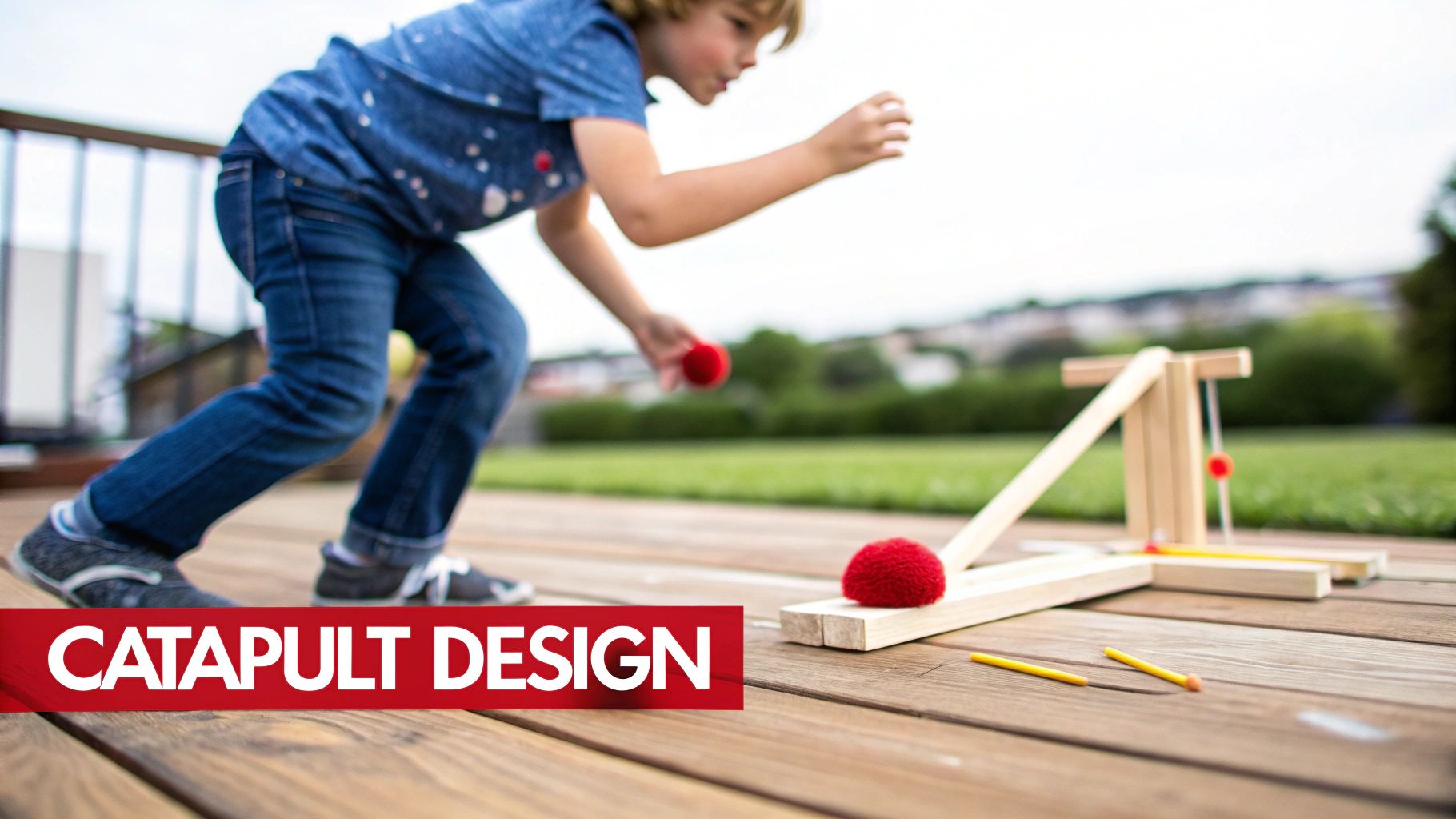
The primary goal is to launch a lightweight object, like a marshmallow or pom-pom, as far or as accurately as possible. This activity naturally encourages experimentation: What happens if you add more rubber bands? How does changing the launch angle affect the distance? This type of hands-on inquiry is featured in many educational settings, from STEM clubs to history lessons on medieval siege weapons, making it a versatile and impactful engineering activity for kids.
Core Engineering Concepts
This launcher project effectively demonstrates key physics and engineering ideas:
- Simple Machines: Kids directly interact with levers (the launching arm) and elastic potential energy (the stretched rubber bands).
- Energy Conversion: They witness stored potential energy in the rubber band convert into kinetic energy as the projectile flies.
- Trajectory and Variables: The activity provides a clear look at how variables like launch angle, force, and projectile mass affect the flight path.
Actionable Insights: How to Get Started
Set up a structured yet fun environment to guide the engineering process and maximize learning.
- Define the Mission: Challenge kids to either launch a projectile the farthest distance or hit a specific target.
- Gather Materials: Provide a simple kit with craft sticks, rubber bands, a plastic spoon or bottle cap, and safe projectiles.
- Measure and Record: Use a tape measure to track distance and encourage kids to log their results. Discuss how changing one variable, like the fulcrum's position, impacts the outcome.
- Discuss History and Modern Use: Connect the activity to historical catapults and trebuchets, and then discuss modern applications of launch technology, from aircraft carriers to space exploration.
3. Circuit Building and Electronics Exploration
Diving into the world of electronics, circuit building is a fantastic engineering activity for kids that illuminates the invisible forces of electricity. This activity demystifies electrical engineering by allowing children to construct simple circuits with batteries, wires, LEDs, and switches. By connecting these components, kids learn how electricity flows, why certain materials conduct it, and how to control its path to create light, sound, or motion.
The initial goal is simple: make a light bulb glow. From there, the possibilities expand into creating functional gadgets like simple flashlights, alarms, or even light-up greeting cards. This hands-on approach provides a tangible connection to the technology that powers their world. The popularity of kits like Snap Circuits and modular electronics from littleBits, founded by Ayah Bdeir, demonstrates how effective this method is for introducing complex concepts in a playful, accessible manner. For a deeper look, you can learn more about advanced electronic circuit board engineering toys.
Core Engineering Concepts
This activity makes abstract electrical engineering principles concrete and understandable:
- Electrical Flow: Kids see a direct cause-and-effect relationship between a closed circuit and a working component (like an LED lighting up).
- Component Function: They learn the specific roles of different parts, such as a battery (power source), wires (conductors), and a switch (controller).
- Schematic Thinking: Building a physical circuit from a diagram (or vice versa) introduces the fundamentals of engineering blueprints and symbolic language.
Actionable Insights: How to Get Started
Setting up a circuit-building station is easy and opens the door to endless experimentation and discovery.
- Start Simple: Begin with a basic circuit: a battery, two wires with alligator clips, and one LED. Show how the circuit must be a complete loop for it to work.
- Predict and Test: Gather various household items (a paperclip, a rubber band, a coin) and have your child predict which ones will conduct electricity before testing them.
- Build a Project: Create a "quiz board" where connecting a wire to the correct answer completes a circuit and lights up a bulb, making learning interactive.
- Troubleshoot Together: When a circuit doesn't work, don't just fix it. Guide your child through the debugging process. Is the battery connected correctly? Is there a loose connection? This teaches critical problem-solving skills.
4. Paper Engineering: Pop-Up Cards and Mechanisms
Paper engineering is a fantastic activity that merges art, design, and mechanical engineering into one creative pursuit. Kids transform flat sheets of paper into dynamic, three-dimensional structures by designing and building pop-up cards and moving mechanisms. This engaging project introduces them to mechanical principles like hinges, pivots, levers, and linkages, all while sharpening their spatial reasoning and fine motor skills.
The goal is to use cuts and folds to create structures that move or pop up when a card is opened or a tab is pulled. This hands-on process demonstrates how simple actions can create complex motion. World-renowned paper engineers like Robert Sabuda and Matthew Reinhart have elevated this craft into an art form, inspiring children and adults with their intricate pop-up books. This activity is a staple in STEAM curricula and maker spaces, proving its value as one of the most accessible engineering activities for kids.
Core Engineering Concepts
This activity makes several mechanical engineering principles tangible and fun:
- Mechanisms and Linkages: Children learn how different folds and cuts create simple machines like levers and four-bar linkages that drive motion.
- Spatial Reasoning: They must visualize how a two-dimensional design will fold into a three-dimensional, moving object.
- Prototyping and Iteration: The process involves constant testing and refinement, as kids adjust their designs to make the mechanisms work smoothly.
Actionable Insights: How to Get Started
To bring paper engineering to life, focus on starting simple and encouraging experimentation.
- Master the Basics: Start with a simple V-fold or mouth mechanism before moving to more complex designs. You can find many fascinating paper activities for kids online to get started. Learn more about Paper Engineering projects on playzusa.com.
- Use the Right Materials: Provide heavy cardstock for the main structure and thinner paper for decorations. Use brads or paper fasteners to create pivot points for rotating elements.
- Score Before Folding: For clean, crisp folds, use a ruler and a dull edge (like a butter knife or an empty pen) to score the paper along the fold lines.
- Connect to Storytelling: Encourage kids to build a pop-up book to tell a story. This adds a narrative purpose to their engineering efforts and enhances creativity.
5. Tower Building and Structural Challenges
Tower building challenges kids to construct the tallest or strongest freestanding structure using a limited set of materials. This classic activity introduces fundamental principles of structural engineering, forcing young builders to think critically about stability, load, and geometry. Whether using spaghetti and marshmallows, straws and tape, or newspapers, children learn to solve complex physical problems with simple resources.
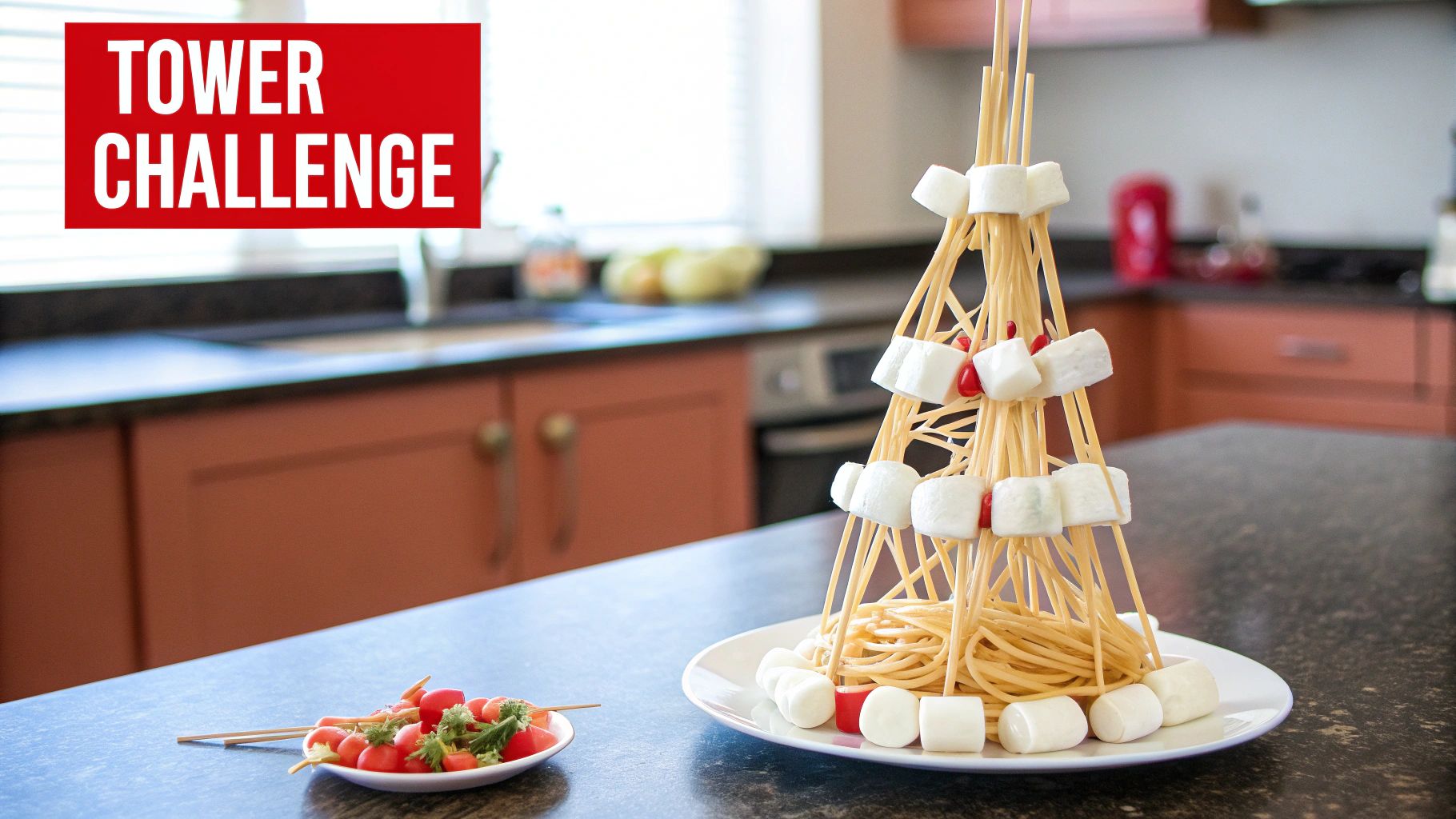
The primary goal is usually to build the tallest possible structure that can support a specific weight (like a single marshmallow) at its peak. This simple objective makes it one of the most engaging engineering activities for kids, famously demonstrated by Tom Wujec’s "Marshmallow Challenge." It's a staple in STEM education, from corporate team-building events to competitions like Destination Imagination, because it reveals deep insights about collaboration and the iterative design process in a fun, accessible format.
Core Engineering Concepts
This challenge makes abstract engineering principles tangible and easy to understand:
- Center of Gravity: Kids discover the importance of a low center of gravity and a wide base for stability.
- Geometric Strength: They learn that triangles are rigid and provide excellent bracing, a concept used in real skyscrapers like the Eiffel Tower.
- Tension and Compression: Participants see how different parts of their structure are pushed together (compression) or pulled apart (tension).
- Material Properties: Experimenting with materials like flexible straws versus brittle spaghetti teaches how to choose the right component for the job.
Actionable Insights: How to Get Started
Setting up a successful tower challenge involves clear rules and encouraging experimentation.
- Establish the Goal: Define the objective clearly. Is it the tallest freestanding tower, or the strongest one? What must it support?
- Impose Constraints: Limit the materials (e.g., 20 sticks of spaghetti, one yard of tape, one marshmallow) and set a time limit (e.g., 18 minutes).
- Prototype and Iterate: Encourage teams to build, test, fail, and rebuild. Documenting different designs with photos can highlight what works and what doesn't.
- Add an "Earthquake Test": Place the finished tower on a tray or piece of cardboard and gently shake it to test its resilience to lateral forces. For more structured challenges, you can explore STEM activities for elementary students on Playz USA.
6. Rube Goldberg Machines and Chain Reaction Contraptions
Building a Rube Goldberg machine is a fantastic way to introduce children to the world of mechanical engineering and systems thinking. These intentionally over-engineered contraptions perform a simple task through a complex and amusing chain of reactions. Using everyday objects like dominoes, marbles, toy cars, and books, kids can design and build elaborate machines that showcase creativity, ingenuity, and a deep understanding of cause and effect.
The main goal is to create a sequence of events where one action triggers the next, culminating in a simple final task like ringing a bell or popping a balloon. This activity has been popularized in media like OK Go's music videos and on YouTube channels like Joseph's Machines, proving its appeal and educational power. It's a premier engineering activity for kids that combines physics, problem-solving, and patience into one incredibly rewarding project.
Core Engineering Concepts
This elaborate activity is a masterclass in several key engineering principles:
- Systems Thinking: Children learn how individual components (subsystems) work together to achieve a larger goal, seeing the machine as a complete system.
- Energy Transfer: They witness concepts like potential and kinetic energy in action as a rolling ball transfers its energy to falling dominoes, which then push a lever.
- Cause and Effect: Every step is a direct lesson in cause and effect, forcing builders to think sequentially and predict outcomes.
Actionable Insights: How to Get Started
Setting up a Rube Goldberg machine requires patience and a methodical approach, mirroring the professional engineering design process.
- Define the Goal: Start with a simple, clear objective, such as "turn off a light switch" or "pour cereal into a bowl."
- Start Small: Encourage kids to begin with a 3 to 5-step chain reaction. They can always add more complexity later.
- Test in Sections: Build and test each small segment of the machine individually before connecting them. This makes troubleshooting much easier.
- Document and Film: Have them sketch their design first. Filming successful runs is a great way to celebrate their hard work and analyze how the machine functions. It's a skill that requires perseverance, as successful runs often take dozens of attempts.
This infographic illustrates the fundamental process flow of a simple Rube Goldberg machine, breaking it down into its core stages.
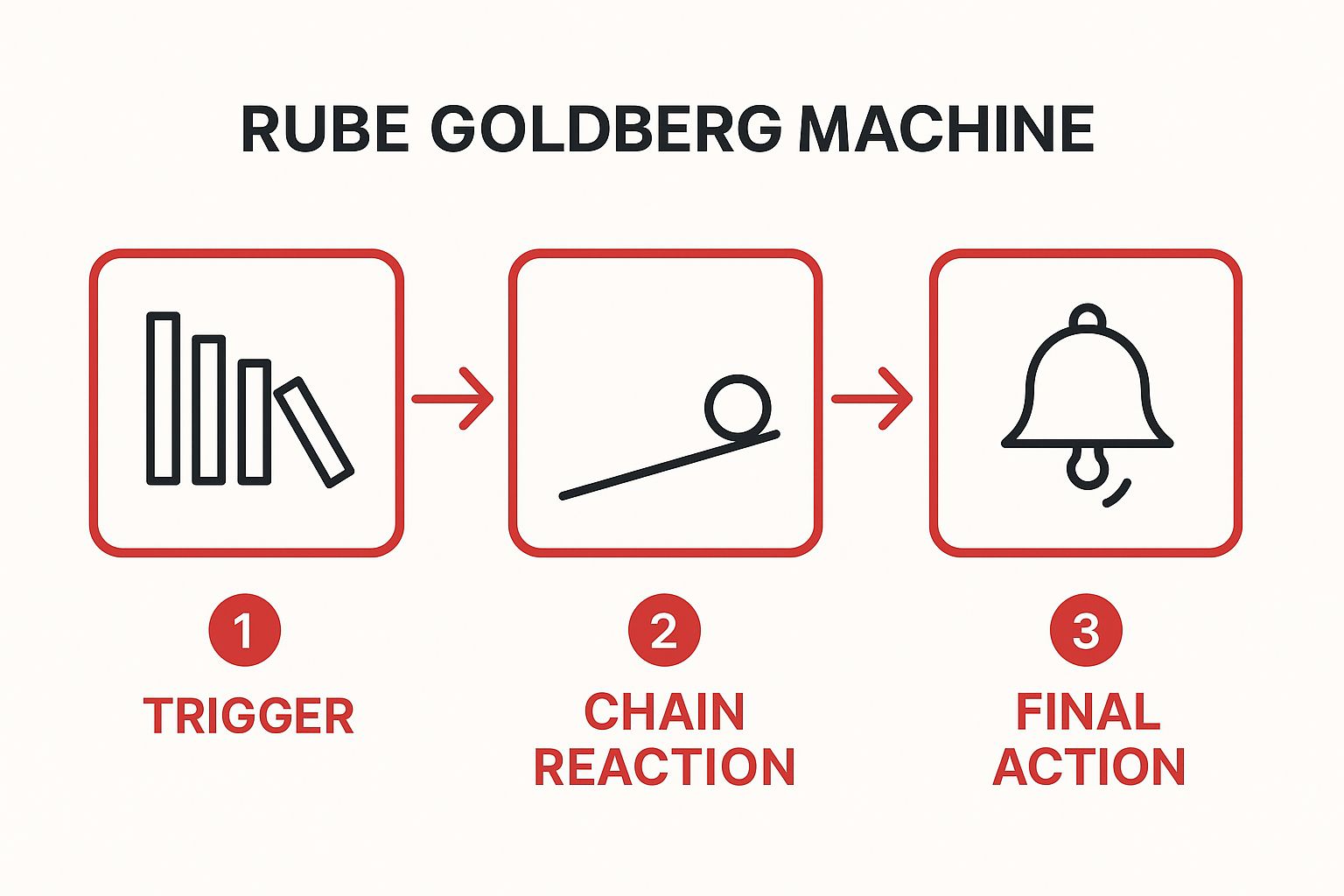
The visualization shows how an initial trigger initiates a series of connected reactions that ultimately lead to the machine's final, intended action.
7. Robotics and Coding with Programmable Robots
Introducing children to robotics and coding bridges the gap between the physical and digital worlds, making it one of the most exciting engineering activities for kids. This activity combines mechanical engineering, electronics, and computer science as kids build and program robots to perform specific tasks, navigate obstacle courses, or respond to sensors. Using visual, block-based coding platforms or text-based languages, children learn essential computational thinking skills in a fun, interactive way.
The challenge involves bringing a machine to life with code, turning abstract commands into tangible actions. This process is at the heart of major global competitions like the FIRST LEGO League and VEX Robotics, which engage thousands of students in collaborative problem-solving. It’s an activity that scales beautifully, from simple floor robots following a colored line to sophisticated kits that allow for complex mechanical builds and advanced programming logic.
Core Engineering Concepts
This activity introduces a powerful blend of modern engineering principles:
- Computational Thinking: Kids learn to break down large problems into smaller steps (decomposition), recognize patterns, and create step-by-step solutions (algorithms).
- Systems Integration: They discover how hardware (motors, sensors) and software (code) must work together to create a functional system.
- Iterative Design & Debugging: The process of testing code, identifying errors (bugs), and fixing them is a fundamental practice in both software and hardware engineering.
Actionable Insights: How to Get Started
To make robotics accessible and engaging, start with clear goals and encourage a "test and learn" mindset.
- Set the Challenge: Create a simple mission for the robot. Can it navigate a maze made of books? Can it push a small ball to a target?
- Start "Unplugged": Before touching a device, try acting out the code. Have your child write down a sequence of steps (e.g., forward, turn right, forward) and have someone else follow them, which helps solidify the concept of sequencing.
- Test and Debug Together: When the robot doesn’t do what's expected, ask questions like, "What did you think it would do?" and "What did it actually do?" This frames debugging as a puzzle, not a failure.
- Progress Gradually: Begin with visual block coding platforms like Scratch or Sphero Edu before moving on to text-based languages like Python. There are many fantastic robotics kits for beginners on playzusa.com that can support this learning journey.
8. Hydraulic and Pneumatic Systems: Water and Air Powered Machines
Exploring the power of fluids is an exciting way to introduce children to mechanical engineering. This activity lets kids build simple machines that use hydraulic (liquid-powered) and pneumatic (air-powered) systems to create movement. Using basic materials like syringes, tubing, and cardboard, they can construct a mechanical arm, a simple lift, or a grabbing claw, all powered by the force of water or air pressure.
The core principle at play is Pascal's law, which states that pressure applied to a confined fluid is transmitted undiminished throughout the fluid. This activity demonstrates how a small push on one syringe can create a powerful force in another, a concept fundamental to heavy machinery like construction equipment and vehicle brake systems. This real-world connection makes these some of the most impactful hands-on engineering activities for kids.
Core Engineering Concepts
This project vividly illustrates several key engineering principles:
- Fluid Power: Kids learn that liquids (hydraulics) and gases (pneumatics) can be used to transmit force and do work.
- Pascal's Principle: They witness how pressure is transferred through a sealed system to move an object.
- Force Multiplication: By using syringes of different sizes, children can see how a small input force can generate a much larger output force.
- Mechanical Advantage: The activity demonstrates how simple machines can make tasks easier, connecting abstract physics to tangible outcomes.
Actionable Insights: How to Get Started
Setting up a hydraulic or pneumatic project is simple and offers a high "wow" factor.
- Set the Challenge: Task your child with building a machine that can lift a small object (like an eraser) or pick something up using only syringes and tubing.
- Start Simple: Begin with a basic two-syringe system. Connect them with a tube filled with water (add food coloring to make it visible) and push one plunger to see the other move.
- Build a Machine: Use cardboard, popsicle sticks, and hot glue to create the structure of a mechanical arm or a scissor lift. Integrate your syringe systems to power its movements.
- Test and Compare: After building a hydraulic system, try the same setup with just air (pneumatics). Discuss the differences in performance. Why is water less "spongy" than air? This introduces the concept of compressibility.
Engineering Activities for Kids: 8-Item Comparison Guide
| Activity | Implementation Complexity 🔄 | Resource Requirements ⚡ | Expected Outcomes 📊 | Ideal Use Cases 💡 | Key Advantages ⭐ |
|---|---|---|---|---|---|
| Building Bridges with Household Materials | Medium - requires workspace & tools 🔄 | Low cost, common household materials ⚡ | Understand structural engineering, load distribution 📊 | STEM classrooms, hands-on engineering intro 💡 | Inexpensive, creativity + engineering blend ⭐ |
| Simple Machines: Designing Catapults | Low to Medium - easy construction 🔄 | Minimal, inexpensive craft supplies ⚡ | Learn simple machines, energy, motion concepts 📊 | Physics demos, experimental play 💡 | Fun, engaging, clear cause-effect relationships ⭐ |
| Circuit Building and Electronics Exploration | Medium to High - needs specific kits/tools 🔄 | Requires batteries, wires, components ⚡ | Grasp electrical flow, circuits, troubleshooting 📊 | Electronics intro, logical thinking exercises 💡 | Scalable complexity, immediate feedback ⭐ |
| Paper Engineering: Pop-Up Cards & Mechanisms | Low to Medium - needs precision & patience 🔄 | Very low cost, mainly paper & craft supplies ⚡ | Mechanical linkages, spatial visualization 📊 | Art-integrated engineering, fine motor skill development 💡 | Very low cost, creative & tactile ⭐ |
| Tower Building and Structural Challenges | Low to Medium - simple materials, space needed 🔄 | Inexpensive, varied materials ⚡ | Structural stability, teamwork, geometry concepts 📊 | Competitions, team-building, quick challenges 💡 | Visual, motivating, promotes iteration ⭐ |
| Rube Goldberg Machines & Chain Reactions | High - complex design & testing 🔄 | Common household items, large space ⚡ | Systems thinking, sequential logic, persistence 📊 | Long-term projects, group collaboration 💡 | Highly creative, interdisciplinary STEM ⭐ |
| Robotics and Coding with Programmable Robots | Medium to High - hardware + software 🔄 | Robots, devices (tablets/computers) ⚡ | Programming, computational thinking, engineering 📊 | Modern STEM education, coding skill-building 💡 | Tangible coding, scalable complexity, community ⭐ |
| Hydraulic and Pneumatic Systems | Medium - fluid mechanics & troubleshooting 🔄 | Syringes, tubing, water, balloons ⚡ | Fluid pressure, force multiplication, real-world engineering 📊 | Physics labs, hands-on mechanical demos 💡 | Visual, powerful motion, real-world connections ⭐ |
From Blueprints to Brilliance: Building Your Child's Future
The journey through the engineering activities for kids we've explored is about so much more than constructing a sturdy bridge or launching a marshmallow across the room. It’s about building a mindset. From the focused precision of creating paper pop-up mechanisms to the complex, systemic thinking required for a Rube Goldberg machine, each project lays a crucial brick in your child's cognitive foundation. These aren't just one-off experiments; they are tangible lessons in problem-solving, resilience, and creative thinking.
When a spaghetti tower wobbles and collapses, a child learns about structural integrity and the importance of a stable base. When a simple circuit fails to light up an LED, they are introduced to the fundamentals of debugging and logical deduction. These moments of "failure" are actually the most valuable parts of the engineering process. They teach the power of iteration, encouraging children to analyze what went wrong, formulate a new hypothesis, and try again with renewed determination. This cycle of design, test, fail, and improve is the very essence of innovation.
The True Takeaway: Fostering an Engineer's Mindset
The most significant benefit of these hands-on projects isn't the finished catapult or the functional hydraulic arm. Instead, it's the invisible toolkit of skills your child develops along the way. You are nurturing key attributes that extend far beyond STEM fields:
- Systematic Thinking: Understanding how individual components, from gears in a simple machine to lines of code in a robot, work together to create a functional whole.
- Creative Problem-Solving: Looking at a limited set of materials, like popsicle sticks and glue, and envisioning a solution to a specific challenge, like spanning a gap.
- Analytical Reasoning: Observing an outcome, whether successful or not, and being able to trace the cause-and-effect relationships that produced it.
- Confidence and Agency: Realizing they have the power to affect the physical world, to build something from nothing, and to solve the puzzles they encounter.
By engaging in these engineering activities for kids, you are empowering them to look at the world not as a series of fixed, mysterious objects, but as a collection of systems and problems they can understand, influence, and even improve. You are giving them the confidence to ask, "How does that work?" and, more importantly, the courage to believe they can figure out the answer. The world needs more thinkers, tinkerers, and innovators, and your living room floor might just be the most important workshop of all.
Ready to take the next step and provide even more structured, engaging challenges? The award-winning kits from Playz are designed by experts to transform complex scientific principles into thrilling, hands-on adventures. Explore our collection at Playz and discover the perfect project to fuel your young engineer's curiosity and passion.
